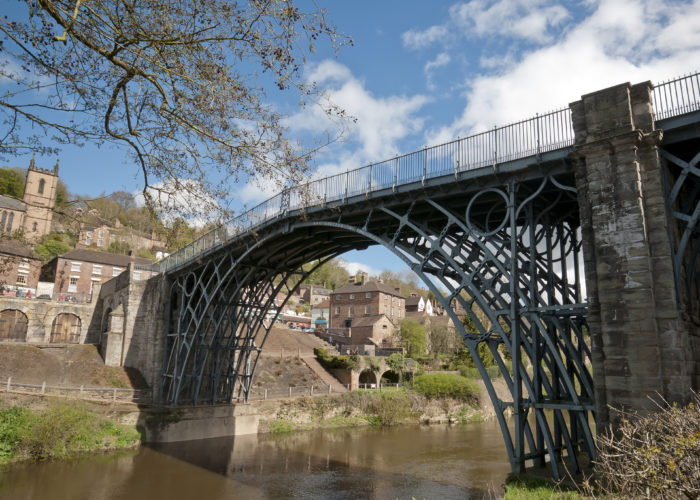The Iron Bridge
This large bridge, at Ironbridge in Shropshire, was the first arch bridge made of iron anywhere in the world. It was built to replace an unreliable ferry service across the River Severn. Opened on New Year’s Day, 1781, it was so successful that it gave its name to the local area.
The Ironbridge Gorge lies within the Coalbrookdale Coalfield which is rich in minerals, including coal and ironstone. By the early 1700s, the region had become a centre for coal mining and iron production.
In 1709, Abraham Darby began to make iron there, using coke as the main fuel instead of charcoal which had always been used before. This was a revolutionary development, which ultimately made it possible to produce iron much more cheaply and in vast quantities. Darby also developed new uses for iron, such as for steam engines, railway tracks and wheels for rail wagons. His methods were adopted by other producers and the smelting and use of iron expanded across Britain throughout the late 1700s.
By the 1750s, Coalbrookdale had become a centre for trade and production. Ferries were used to transport materials across the River Severn between the ironworks and other industries. But this was unreliable – the river was often too shallow in summer and ran too rapidly in the winter. Another solution was needed. In 1773, an experienced bridge designer named Thomas Farnolls Pritchard suggested the idea for the iron bridge. With the area as a pioneering centre of iron production, this would not only be an affordable and robust solution, but would also help showcase the versatility of iron while advertising the skills of the iron producers and bridge builders.
Three years later, a plan had been approved and money raised to begin construction. Abraham Darby III, grandson of Abraham Darby was commissioned to build it. The Iron Bridge is 60m long (about seven times as long as a London Bus) and rises 18m (nearly six storeys) above the River. It consists of 1700 individual iron parts, fitted together with wooden joints. No records have survived as to exactly how it was constructed, and many have speculated about this over the years.
The Iron Bridge has become a lasting and iconic symbol of the Industrial revolution. It’s a Grade I listed structure, which means it is protected, and with the adjacent town of Ironbridge and the Ironbridge Gorge forms the UNESCO Ironbridge Gorge World Heritage Site.
Did you know..?
The final cost of building the Bridge was £6,000. If Abraham Darby had wanted to build such a bridge today, he would have to raise in the region of £1.5 million.
Use our Classroom resources to investigate this object and the themes of Industrial revolution and Transport revolution further.
Highlights:
- Using objects, artworks and other sources to find out about the past
- Enquiry: Was there a transport revolution in the Age of Revolution?
- How to make a revolutionary stop-motion animation
- Revolutionary Top Trumps
And much more…
Sources & ackowledgements
This object description and its related educational resources were researched and written by our team of historians and education specialists. For further information see the item’s home museum, gallery or archive, listed above.
- Related resources
- Enquiry Questions
-
Did you know..?
The final cost of building the Bridge was £6,000. If Abraham Darby had wanted to build such a bridge today, he would have to raise in the region of £1.5 million.
-
Education overview
You can access a range of teachers resources related to this object and more on our education page.
Please also see our glossary of terms for more detailed explanations of the terms used.
-
Curatorial info
- Originating Museum: The Iron Bridge Gorge Museums
- Production Date: 1781
- Material: Iron
- Original record
-
Use this image
- License Type: Creative Commons





